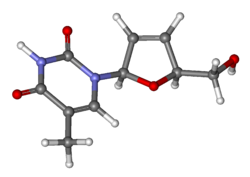
Back Stavudien Afrikaans ستافودين Arabic Stafwdin Welsh Stavudin German Estavudina Spanish استاوودین Persian Stavudiini Finnish Stavudine French Stavudin ID サニルブジン Japanese
 | |
 | |
| Clinical data | |
|---|---|
| Trade names | Zerit |
| Other names | 2′,3′-didehydro-2′,3′-dideoxythymidine |
| AHFS/Drugs.com | Monograph |
| MedlinePlus | a694033 |
| License data | |
| Pregnancy category |
|
| Routes of administration | By mouth |
| ATC code | |
| Legal status | |
| Legal status | |
| Pharmacokinetic data | |
| Bioavailability | >80% |
| Protein binding | Negligible |
| Metabolism | Kidney elimination (~40%) |
| Elimination half-life | 0.8–1.5 hours (in adults) |
| Identifiers | |
| |
| CAS Number | |
| PubChem CID | |
| DrugBank | |
| ChemSpider | |
| UNII | |
| KEGG | |
| ChEMBL | |
| NIAID ChemDB | |
| CompTox Dashboard (EPA) | |
| ECHA InfoCard | 100.169.180 |
| Chemical and physical data | |
| Formula | C10H12N2O4 |
| Molar mass | 224.216 g·mol−1 |
| 3D model (JSmol) | |
| |
| |
| (verify) | |
Stavudine (d4T), sold under the brand name Zerit among others, is an antiretroviral medication used to prevent and treat HIV/AIDS.[3] It is generally recommended for use with other antiretrovirals.[3] It may be used for prevention after a needlestick injury or other potential exposure.[3] However, it is not a first-line treatment.[3] It is given by mouth.[3]
Common side effects include headache, diarrhea, vomiting, rash, and peripheral nerve problems.[3] Severe side effects include high blood lactate, pancreatitis, and an enlarged liver.[3] It is not generally recommended in pregnancy.[3] Stavudine is in the nucleoside analog reverse-transcriptase inhibitor (NRTI) class of medication.[3]
Stavudine was first described in 1966 and approved for use in the United States in 1994.[4] It is available as a generic medication.[3]
- ^ Cite error: The named reference
Stavudine FDA labelwas invoked but never defined (see the help page). - ^ "Zerit EPAR". European Medicines Agency (EMA). 17 September 2018. Retrieved 13 October 2020.
- ^ a b c d e f g h i j "Stavudine Monograph for Professionals - Drugs.com". www.drugs.com. Archived from the original on 10 November 2016. Retrieved 9 November 2016.
- ^ Fischer J, Ganellin CR (2006). Analogue-based Drug Discovery. John Wiley & Sons. p. 505. ISBN 9783527607495. Archived from the original on 8 September 2017.